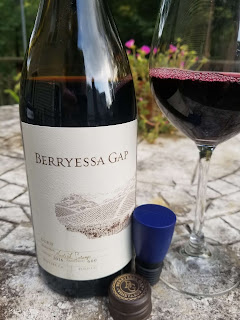 Wines of Chile list 16 valleys noted for wine production and for a quarter of a century, Veramonte Vineyards has been farming in the "the trailblazing cold-climate wine-producing region of Chile": the Casablanca Valley. Over time they also set roots in the Colchagua Valley which has "evolved over the last twenty years from being a calm stretch of farmland to becoming one of the largest and most active wine-producing regions in the country." Today the wine is part of the Gonzalez Byass family and produces seven organic varietal wines from these two appellations.
Wines of Chile list 16 valleys noted for wine production and for a quarter of a century, Veramonte Vineyards has been farming in the "the trailblazing cold-climate wine-producing region of Chile": the Casablanca Valley. Over time they also set roots in the Colchagua Valley which has "evolved over the last twenty years from being a calm stretch of farmland to becoming one of the largest and most active wine-producing regions in the country." Today the wine is part of the Gonzalez Byass family and produces seven organic varietal wines from these two appellations. The Casablanca Valley is "known for the marine influence of the Pacific Ocean that cools off its climate, the morning fog that settles into the valley, and the old, granite-clay soils that create a rich tapestry of terroir. All these factors play a part in making this valley one of the main producers of white wine in Chile. The higher, warmer altitudes free from frosts are ideal for red varieties such as Merlot and Syrah, while the lower and cooler areas are favorable for vibrant white wines with a signature minerality that cause Sauvignon Blanc and Chardonnay to be the most iconic varieties of the Casablanca Valley".
The Casablanca Valley is "known for the marine influence of the Pacific Ocean that cools off its climate, the morning fog that settles into the valley, and the old, granite-clay soils that create a rich tapestry of terroir. All these factors play a part in making this valley one of the main producers of white wine in Chile. The higher, warmer altitudes free from frosts are ideal for red varieties such as Merlot and Syrah, while the lower and cooler areas are favorable for vibrant white wines with a signature minerality that cause Sauvignon Blanc and Chardonnay to be the most iconic varieties of the Casablanca Valley". The Colchagua Valley is located in the southern half of the Rapel Valley and the "relatively low altitude of the coastal hills allows the Pacific breeze to mingle with the Andean winds, which cools the valley and prolongs the maturation period of the region. This is advantageous for the preservation of acidity in the grapes and helps to generate red wines with excellent coloring, great freshness, and very good keeping qualities. The large majority of wine produced here is red, with a particular propensity for the production of Carménère, Cabernet Sauvignon, and Merlot. Although, the newer plantations close to the coast have also proven to be a region with great potential for cool-climate white wines".
The Colchagua Valley is located in the southern half of the Rapel Valley and the "relatively low altitude of the coastal hills allows the Pacific breeze to mingle with the Andean winds, which cools the valley and prolongs the maturation period of the region. This is advantageous for the preservation of acidity in the grapes and helps to generate red wines with excellent coloring, great freshness, and very good keeping qualities. The large majority of wine produced here is red, with a particular propensity for the production of Carménère, Cabernet Sauvignon, and Merlot. Although, the newer plantations close to the coast have also proven to be a region with great potential for cool-climate white wines". 
In both valleys, Veramonte follows organic practices in order to "express the fullest potential of the terroir". These practices are augmented with in-house compost; row cultivation to minimize erosion; incorporation of animals like sheep to cut grass and act as a natural fertilizer; conservation of biological corridors to ensure a self-regulated ecosystem for healthy vines; pruning and canopy handling that allows for proper ventilation and disease prevention; and undergrowth control that unpacks the soil, generates structure and enhances the life and soil microfauna.
Veramonte Organic Sauvignon Blanc 2019 ($11.99)
Sourced from the Casablanca Valley this was my favorite of the trio and expressed an old-world style in contrast to more popular lemongrass dominated Sauvignon Blanc. Citrus is present, much more subdued, coexisting with considerable depth, and finishing with refreshing acidity.
Veramonte Organic Pinot Noir 2018 ($12.99)
Also from the Casablanca Valley, this is a very pleasant wine with sour cherries throughout. It presents a satisfying balance between tannins and acidity.
Veramonte Organic Carmenere 2018 ($11.99)
Sourced from the warmer Colchagua Valley this wine expressed blue fruits like plums and blueberries that are rich in concentration with rising acidity. Would prefer a little more tannic structure.
Disclosure: We received samples from Veramonte in order to share our opinion about their products, but this isn’t a sponsored post.















































